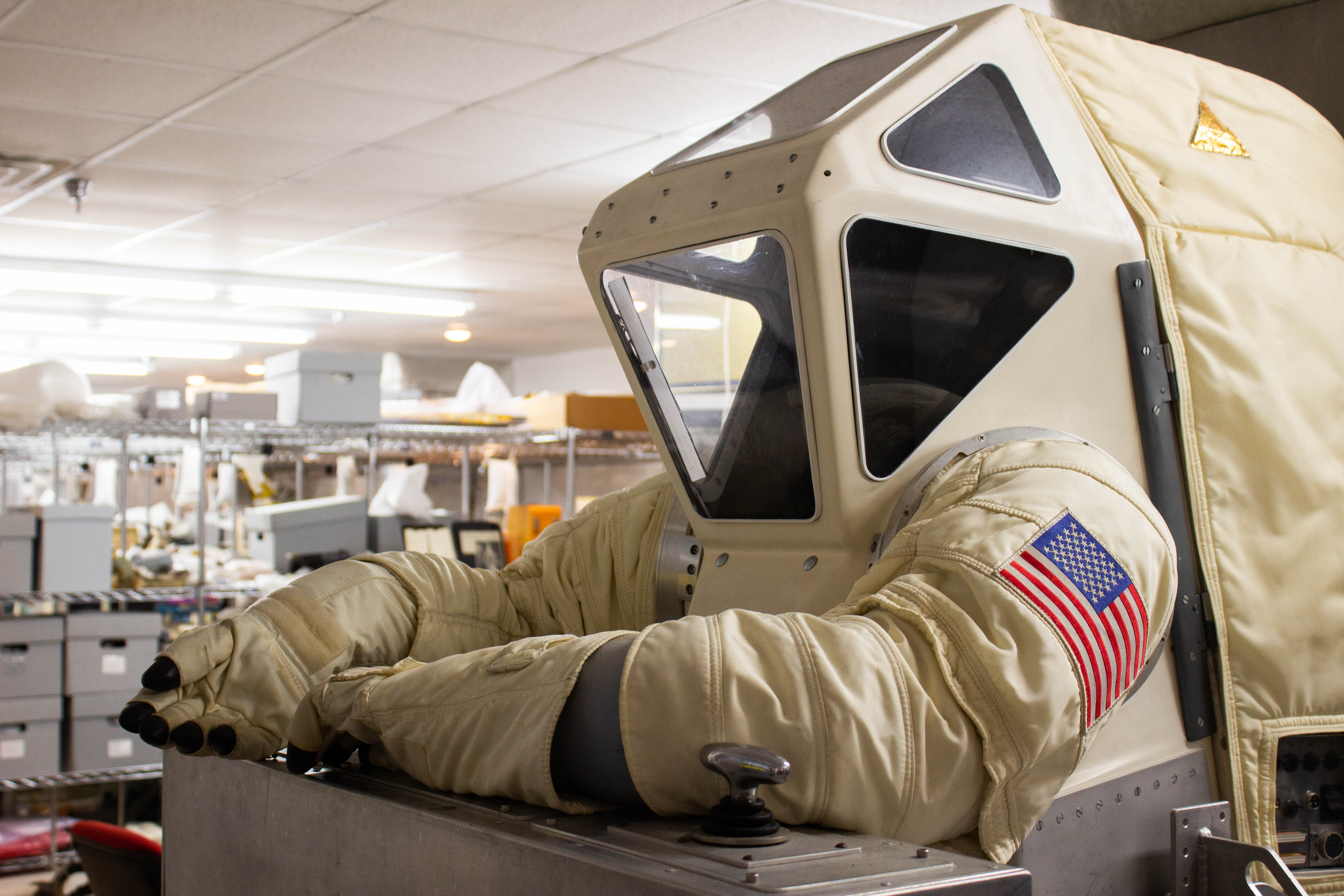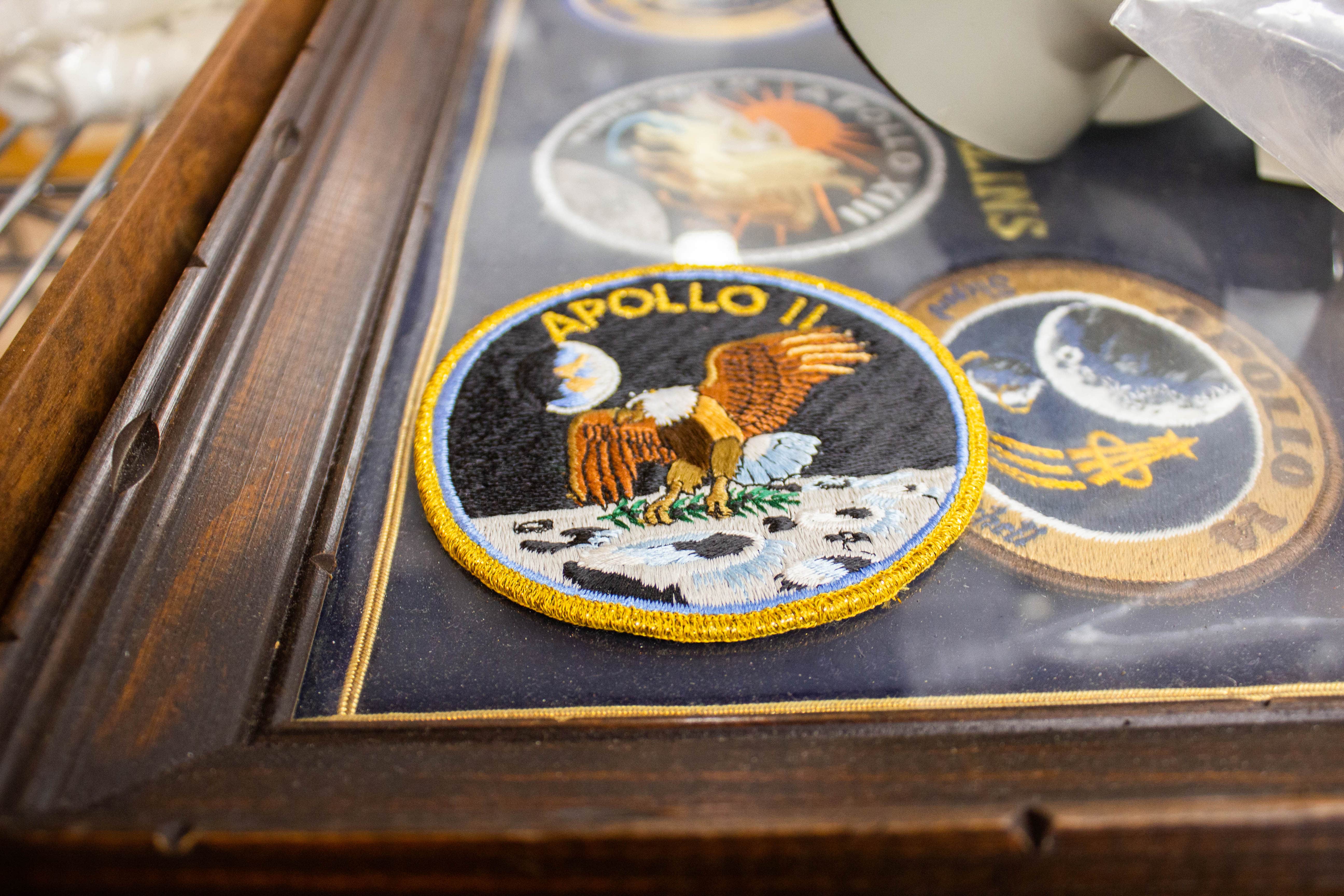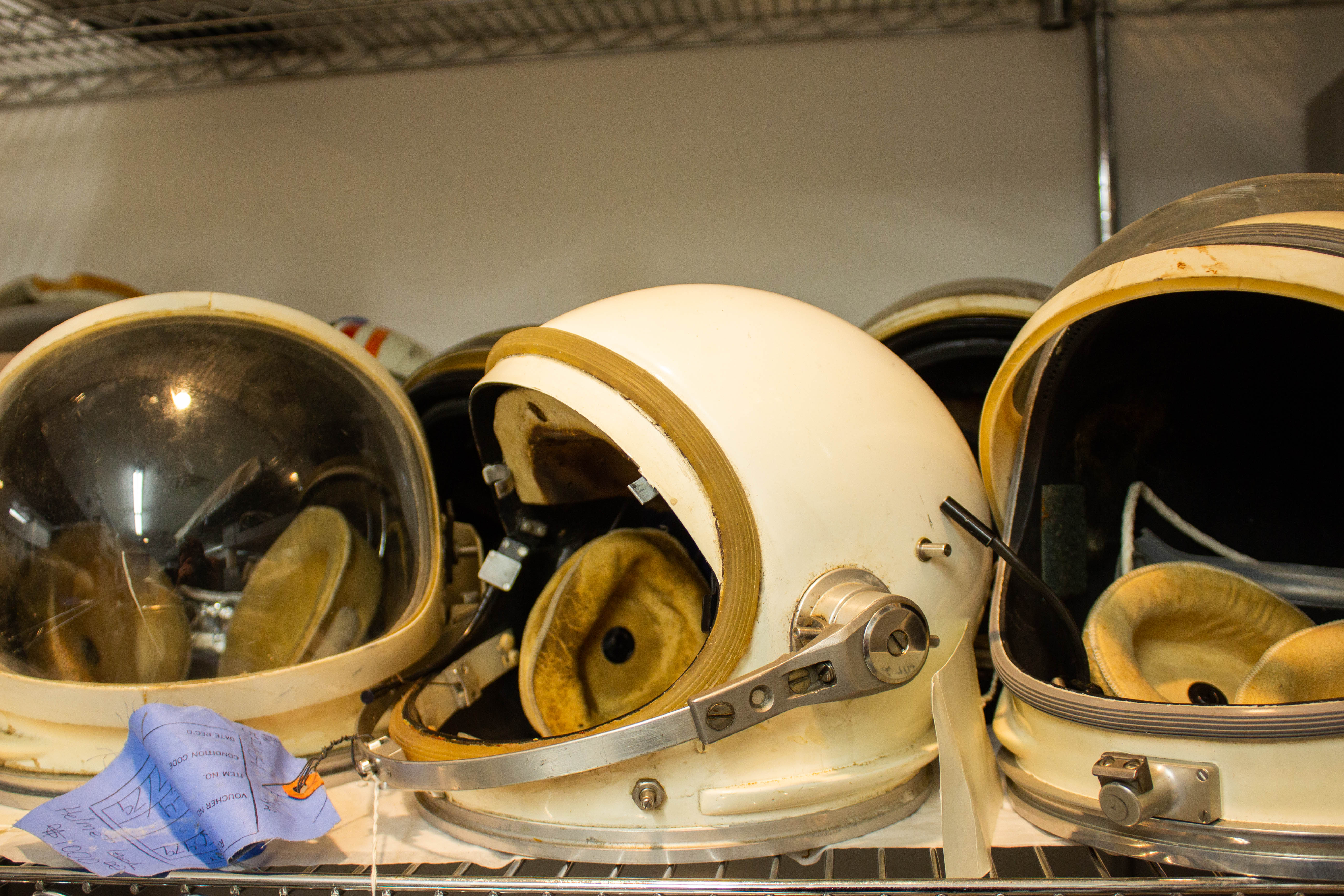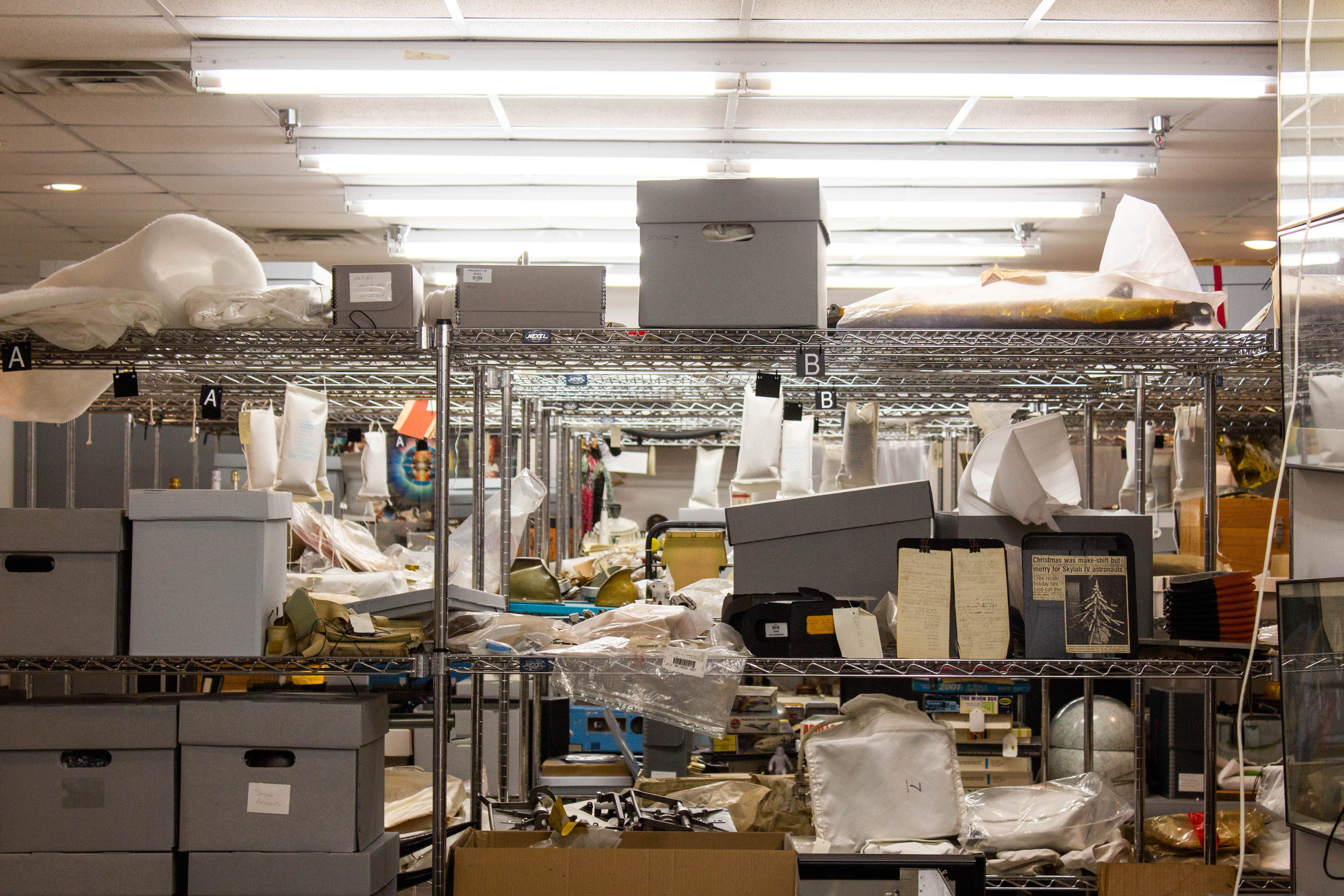Preserving—And Telling—Space History
17:24 minutes

 This story is part of our celebration of the 50th anniversary of the Apollo 11 mission. View the rest of our special coverage here.
This story is part of our celebration of the 50th anniversary of the Apollo 11 mission. View the rest of our special coverage here.
We’ve all heard the iconic stories of the early space program—from Kennedy’s “We choose to go to the moon” speech, to The Right Stuff, to Armstrong’s “one small step,” to the dramatic story of Apollo 13.
But how do we find new stories to tell, locate hidden figures of history, or even know they exist? The answer may lie in museum collections, old paper archives, and in the memories of ordinary people. Ed Stewart, the curator of the U.S. Space and Rocket Center, and Reagan Grimsley, head of Special Collections and Archives at the University of Alabama-Huntsville, join Ira to talk about preserving artifacts of the early space program, and the importance of the archival record in telling the tales of historic space flight.
Take a peek into the storage room of the U.S. Space and Rocket Center in Huntsville, Alabama.



Ed Stewart is curator of the U.S. Space and Rocket Center in Huntsville, Alabama.
Reagan Grimsley is head of Archives and Special Collections at the University of Alabama-Huntsville.
IRA FLATOW: This is Science Friday. I’m Ira Flatow, coming to you from the US Space and Rocket Center in Huntsville, Alabama.
[APPLAUSE]
This summer marks the 50th anniversary of the Apollo Moon landing. And you know the popular stories, right? Kennedy’s speech, the Wright stuff, the one small step, Apollo 13? But how do we find out those hidden nuggets, or even know they exist?
Well, you ask the archivists, the curators of the artifacts stored in museums like this one, or in boxes of old paper, fading photos, dusty records. And two of those archivists are here with us today. Ed Stewart is the curator of the US Space and Rocket Center right here in Huntsville. Welcome to Science Friday.
[APPLAUSE]
And Reagan Grimsley is Head of Special Collections and Archives at the University of Alabama in Huntsville. Thanks for being here.
[APPLAUSE]
And for everybody who’s not in the audience here, who doesn’t know as much as we do about Huntsville, what is Huntsville’s special role in space history? Why are we here?
ED STEWART: Well, Huntsville’s claim to fame for the space program is all things propulsion. If there is a rocket that was built especially for the early space program and even into the space shuttle program, that engine on the bottom of that rocket was probably designed and may have been built here in Huntsville.
IRA FLATOW: Now you’re the curator at the Space and Rocket Center. Give us an idea of some of your favorite artifacts that are here.
ED STEWART: Well, there’s the easy one, which is our Saturn V that we have in the hall just outside the theater here.
IRA FLATOW: That’s a big exhibit.
ED STEWART: It is.
IRA FLATOW: Getting a Saturn V in a building, lying down.
ED STEWART: Yes, just under 400 feet of length, and the building is built around it, basically. And it’s the largest object in the Smithsonian’s collection that we have here. And then we also have amazing things that come from the history of the people that developed the program. Childhood notebook of Wernher von Braun and technical documentation from the computers that operated the Saturn V. So it’s a phenomenal selection.
IRA FLATOW: And Reagan, you’re an archivist and head of the special collections at the university here. What’s so special about these special collections when it comes to space?
REAGAN GRIMSLEY: Well, UAH is pretty unique in that we’re one of few academic archives in the United States that actually collects space materials. That role usually falls to the Smithsonian or other governmental agencies, NASA. So we have had a very integral relationship with the space program dating back to the 60s. Wernher von Braun secured funding for our research institute, and we started collecting Saturn V documents, actually, in 1968, before the first Apollo missions reached the moon.
IRA FLATOW: Ed, what stories can you get what? What does an old rocket tell you?
ED STEWART: Anything from– and especially here, because we focus on propulsion, we get an opportunity to look at the piece parts. And then from the piece parts, you see the names on the documents, and you can learn about the individuals that contributed to the development of the J2 engine or the F1 rocket engine. And from my perspective, it’s through that hardware that you find the stories about the people that built it that spent their nights and weekends slaving away to achieve this really fantastical goal.
IRA FLATOW: So if you look through it, you can find serial numbers on old parts and stuff like that?
ED STEWART: Absolutely. Every piece of NASA hardware, especially those used on the Saturn V, has something called the data plate. And that data plate gives you a serial number, the date of manufacture, the company, the contract number, all these breadcrumbs that you can use to trace back to a lab, a manufacturing facility, any direction you might need to go in order to identify it.
IRA FLATOW: And you have a dual role here. You want to put these objects on display for people to look at in your museum. What about preserving and restoring them? Do you work on that? Is it like having in a garage? You go in on a Saturday and you want to restore your old car?
ED STEWART: Eh. Let me put it this way we don’t let me near the paint brushes.
[LAUGHTER]
No it’s a bit more complicated than that. We do a lot of work, especially since a lot of our display is outdoors. We do a lot of work to make sure we understand what it is that we’re dealing with and then taking the best steps to preserve it. And hopefully most of the work is preservation rather than restoration because you want to keep what’s there if you at all possibly can.
IRA FLATOW: Because I guess a lot of people look at them and they say, hey, this stuff is built out of strong material, but some of it is pretty fragile.
ED STEWART: That’s correct. The one thing that people think of is this is a big metal rocket. It’s so robust, it should be able to sit outside forever and ever and ever. And that is just about as far from the truth as you can get. The engineers did not think about putting it on display in a park in 50 years in the future. They were thinking about, I need this thing to not blow up and get its payload to where it’s going to go. And so thinking about whether or not a pigeon was going to make his nest in it was not on their list. So we do a lot of trying to keep the animals out, trying to keep it clean, and just everything we can to maintain them.
IRA FLATOW: You gave me a tour of the back of the archives in the attic today, and one of the things you pointed out– the most fragile thing in your archives, you said, were the space suits.
ED STEWART: Yes.
IRA FLATOW: Tell us why that is.
ED STEWART: So space suits are incredibly finicky. Of course, they are designed to be airtight. Very important feature of a space suit. And they’re made up of, depending on the suit, up to 21 different layers. And a lot of it, because of the time in which they were made, a lot of the polymers or the rubbers are natural rubbers, so they break down quickly. Those layers like to trap air, humidity, and everything in between them.
So you have to be super careful with handling them if the rubber has started to become rigid, super careful about the temperature and the humidity and the light levels to keep those microclimates from forming inside a suit and basically creating a pocket of humidity for mold to grow. So they’re super, super finicky to deal with.
IRA FLATOW: Hm. Reagan, a lot of early NASA archives were focused on preserving the technology, have engineering documents and spec sheets and things like that. But we know from the history that there were great stories about people who did all these things. How do you get the stories about the people preserved?
REAGAN GRIMSLEY: Yeah, that’s a good question because a lot of the early documentation was purely technical. People wanted to make sure that they documented this great achievement of being able to send man to the moon and return him safely. It’s only later that we really begin to see the context of humans in that record, and we have to remember that about 400,000 people worked on the Apollo project. And almost 4% of the US budget in the late 60s was devoted to that program.
So you had a large number of people working on a project. And a lot of those people didn’t have a lot of background and training. Some of them were local people here from Huntsville that went to work for NASA and worked their way up or whatnot. So they just assumed that everybody knew the story, right? I mean, it’s like us here in Huntsville. We drive by the rocket every day. Sometimes I think we shouldn’t, but we take it for granted.
And so as people begin to age, I think they begin to tell their children these stories or to reminisce about it, and that’s when we start to see it come into the archival record. And numerous times, I’ve had people who wanted to donate their father’s papers or wanted to donate their grandfather’s papers and they would bring technical notebooks.
And I would say, well, do you have a photo? Do you have some stories? Do you have some reminiscences? Do you have something so that we can see the people behind this? And so now, whenever we solicit collections, we solicit that type of material specifically because we want to see how the people fit in the picture.
IRA FLATOW: Let me ask both of you. I’m going to ask you first, Ed.
ED STEWART: Sure.
IRA FLATOW: Do you have a favorite artifact in your whole museum or collection or in the attic? I saw all kinds of stuff.
ED STEWART: Wow.
IRA FLATOW: It’s like asking about your children?
ED STEWART: Yes, it’s which one is your favorite kid? Um, yes. From a paper documentation standpoint, we have the only copy of Wernher von Braun’s doctoral thesis, which is kind of a super, super historically critical thing. It’s, of course, all written in German, typed, except for the formulas, which are handwritten, and then photographs pasted in onto the individual pages. It’s a marvelous historic document.
From an object standpoint, there’s the tiniest part of the Saturn V. There are these little tiny magnetic donuts that make up a 1 or zero inside the launch vehicle digital computer, and they are a fraction of a fraction of an inch in diameter.
IRA FLATOW: Core memory.
ED STEWART: Yes. Magnetic core memory.
IRA FLATOW: I remember that from my 1960s popular science days.
ED STEWART: That’s exactly right. And they would take these little magnetic donuts and sew them by hand into these planes in between two copper wires. And if it spun one way, it was a 1, if it spun the other way, it was a zero when you ran current through it. So it’s one of my handful of top tier favorites.
IRA FLATOW: And Reagan, do you have your favorite?
REAGAN GRIMSLEY: I think one of the favorite things that I have in our collection is something almost not from Apollo, but one of them went and wrote a book called Das Marsprojekt. And we have a signed copy. And ours is special because it was given by Wernher von Braun to Willy Ley, the author who came to America from Germany in the 1930s.
Unfortunately, left all of his book collection behind. It was actually taken from him before he left. But then as he came to America, he began to rebuild it. And he was really one of the people who popularized rocketry after World War II. So that has to be one of my favorites.
IRA FLATOW: That’s great. Yes ma’am?
AUDIENCE: So you’ve already answered my initial question, which was how do you decide whether or not a document or an object is historically significant enough to include in the archives? But my follow up to that is what do you do if you decide that it’s not significant enough to include in the archives? Does it go back to the family or go to a different collection?
IRA FLATOW: Reagan, you want to take that?
REAGAN GRIMSLEY: Yeah. We have a process by when someone gives us a collection, we have a signed donor agreement that tells us exactly what they’re giving to us. And part of that is a what to do with materials that we might not want. And many times, we try and not take things that we don’t think we’d accession into our collection, but it does happen.
One thing that happens quite frequently is you get something with personal identification on it– for example, social security numbers or something along those lines– that we just really wouldn’t want in public circulation. So we’ll usually ask the family to take that back. But we, by law, cannot give away or sell things because we’re a state entity. So we can’t offer it up to the highest bidder.
Interesting story related to this. We have a very large collection of science fiction books, many of which are from the 40s, 50s, and 60s. And we’re cataloging those and we finding duplicates. And I had a gentleman in a couple of weeks ago. He says, I see that you have a duplicate of the Star Trek book. You really don’t want to give that one away. It’s worth a lot of money.
So these things, they have monetary value. So sometimes we keep them or we give them back to the donor when we can. But that’s usually written into our donor agreement so that they’re not floating around out there because there is a large space collectors market out there.
IRA FLATOW: Can you digitize them so we can all read them? Put them online?
REAGAN GRIMSLEY: We’re working on that, but it takes a long time.
IRA FLATOW: And money, I’ll bet.
REAGAN GRIMSLEY: Yeah, it takes a lot of money. And I think that’s the common phrase that we always hear is it’s all on the internet. And that’s just simply not true. And we invest a lot of time and money into selectively digitizing things that we think people will want to see.
IRA FLATOW: That’s great. I’d like to see a lot of that. Yes, sir?
AUDIENCE: What steps would someone have to go through to be able to view the archives in person?
IRA FLATOW: Yeah, who do you have to be? Special? Somebody special?
ED STEWART: No. So because most archives are considered a public trust, we are available for research and investigation. And for us specifically, we have an application on our web page that you go in, you submit your application, you tell us what it is you’re interested in, and then we reach out to you and contact you and try and schedule it. Because for us, we have a fairly small team so we have to manage our time and with all the projects that we’re doing. And then we try and fit you into the schedule.
IRA FLATOW: Now Reagan, I know that you and your archives were involved with the making of a documentary movie about the Apollo. Tell us about that.
REAGAN GRIMSLEY: Yeah. We were involved in the documentary when we were Apollo. The producer of that came out and talked to me, and I was lucky enough to be able to get him in touch with the right people, and also served as a scholar on the grant. Helped him get an Alabama media grant. Hopefully ABTV will run the documentary this summer.
But we’re also collecting stories as part of that. We’re going to serve as the archive for all of the material that they’ve collected. So for us, the interest in working with them was to be able to collect all of these stories from people who have memories of Apollo or who worked on the project. And I have to tell this one story.
So we had a gentleman who comes in and volunteers for us, John Rankin. And I know John because we’re both from Mississippi. John’s lost his accent. I haven’t.
[LAUGHTER]
But he wound up working for Boeing because he was working at a paper mill as an engineer. And he was going through and reading a magazine, and they had a little forms to fill out. And he filled out a form and got a job offer from Boeing. Went to work in Seattle and wound up being one of the top people in safety protocols.
And we see he’s featured partly in the documentary about the Apollo fire and sneak circuit technology. He was really the top person in that field. But that goes to show you how that average person out there can sometimes wind up being a very important part of history.
IRA FLATOW: And you take these oral histories and you find out these things.
REAGAN GRIMSLEY: You get wonderful stories.
IRA FLATOW: Yeah. I’m Ira Flatow. This is Science Friday from WNYC Studios. All right. Now last question for both of you because we live in an age of digital things, right? Virtual stuff. You’re dealing with an age where there were tangible things, right?
ED STEWART: Mm-hmm.
IRA FLATOW: What is your advice now to the space chrome program? What should it be doing now to preserve the things for future archivists? What should they be doing?
ED STEWART: Print it out.
[LAUGHTER]
And I say that because from my perspective, if it’s a document, so much is being stored digitally. And file formats– we face this as archivists– file formats change. And file formats become obsolete. And so if you have a document, a hard copy, a piece of paper, will last you way, way, way longer than a magnetic disk or a CD.
IRA FLATOW: Reagan?
REAGAN GRIMSLEY: I agree to a certain extent. One of our problems is that a lot of the things that we get now are only digital. And it’s almost impossible to print them out. In the past, when someone brought you a stack of photographs, they were going to be there for a while as that says. They’re bringing you something physical. And now, somebody brings you a SIM card. And we have to figure out ways to deal with that.
We had a conference about a year ago called Tivoli Preserve that a group of archivists and museum curators and space collectors got together talking about this very question. We looked back 50 years. We look forward 50 years. What is the future going to look like? And one of the things that I tell folks is that in 50 years, people are going to be writing histories based on our cell phones. The archival artifact is going to be your cell phone, Ira. And that’s what we’re going to be writing history from because that’s what we keep our day-to-day lives on.
IRA FLATOW: Some people look at my phone and say it’s already an archive. It’s so old.
[LAUGHTER]
Thank you, gentlemen. Thank you both. It was fascinating conversation. Ed Stewart, curator of the US Space and Rocket Center right here in Huntsville. Reagan Grimsley, head of a special collections and archives at the University of Alabama in Huntsville. Thank you for taking time to be with us today.
[APPLAUSE]
Copyright © 2019 Science Friday Initiative. All rights reserved. Science Friday transcripts are produced on a tight deadline by 3Play Media. Fidelity to the original aired/published audio or video file might vary, and text might be updated or amended in the future. For the authoritative record of Science Friday’s programming, please visit the original aired/published recording. For terms of use and more information, visit our policies pages at http://www.sciencefriday.com/about/policies/
As Science Friday’s director and senior producer, Charles Bergquist channels the chaos of a live production studio into something sounding like a radio program. Favorite topics include planetary sciences, chemistry, materials, and shiny things with blinking lights.
Katie Feather is a former SciFri producer and the proud mother of two cats, Charleigh and Sadie.
Ira Flatow is the founder and host of Science Friday. His green thumb has revived many an office plant at death’s door.